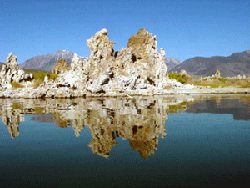 If you take a hike to higher elevations anywhere around the June Lake Loop, or if in wintertime you are skiing or snowboarding June Mountain, chances are you will catch a view of Mono Lake to the north. Mono Lake is also visible as are you traveling around the June Lake Loop Road, just north of Grant Lake. This ancient, landlocked body of water filled with history, beauty and mystery, is approximately 10 miles north of June Lake.
If you take a hike to higher elevations anywhere around the June Lake Loop, or if in wintertime you are skiing or snowboarding June Mountain, chances are you will catch a view of Mono Lake to the north. Mono Lake is also visible as are you traveling around the June Lake Loop Road, just north of Grant Lake. This ancient, landlocked body of water filled with history, beauty and mystery, is approximately 10 miles north of June Lake.
Its mineralized, salty waters sustain a unique ecosystem. Mono Lake has two volcanic islands named Negit and Paoha; unusual limestone formations called Tufa, and beautiful shorelines within a geographic basin incorporating a volcanic landscape and bordered on the west by the dramatic eastern escarpment of the Sierra Nevada. It is famously a major refuge and waypoint for migratory birds.
Mono Lake is considered a volcanically active area: the Panum Crater just south of the lake, as well as Paoha Island, are thought to have been formed by eruptions as little as 350 years ago.
When you visit the Mono Lake area, you can enjoy the spectacular tufa towers through a self-guided walking tour on the shoreline at the South Tufa area on the Seal Beach side of the lake, accessed by State Route 120 east. These unusual formations are piled-up calcium carbonate deposits precipitated beneath the water's surface where spring water rising from underground mixes with the lake water: then the "towers" are exposed when the lake level lowers.
There is also a County Park on the north shore of the lake, which is ideal for picnics and gatherings; and the old Marina area provides for vehicular access along US Highway 395 to a boardwalk at the western shore. The community of Lee Vining, which in its history was originally called "Lakeview," is located along US Highway 395 near Lee Vining Creek, overlooking the lake.
Rush Creek, flowing from the June Lake Loop area, and Lee Vining Creek from Tioga Pass, are the two main tributaries which flow in to this inland sea. The Los Angeles Department of Water and Power began diversion projects of the water from these streams beginning in the late 1930's, which threatened the very existence of Mono Lake. Legal efforts were mounted some thirty years later to curtail the diversion of source water, maintaining the lake's viability as a life-giving resource for wildlife and humans alike.
Due to the high salinity and mineralization of the water in Mono Lake, there are no fish here: however, an abundance of planktonic algae provides support for a food chain. Conditions are ideal for the proliferation of Artemia (brine shrimp). Historically the tiny brine shrimp of Mono Lake have been commercially harvested and marketed as fish food for aquarium owners. In addition, these organisms provide nutrition for large numbers of many species of birds. Notably, Negit island is the prime nesting ground for the California Gull, Larus californicus, where the eggs may be safe from most predators. Also present within the waters are the larvae and pupae of a distinct species of fly, the Ephydra hians. These alkali flies, once hatched, continue to inhabit the sandy areas at the shore and will erupt into clouds as they move timidly away from intruders who walk through the area. Interestingly, these adult flies can encapsulate themselves in small air bubbles in order to re-enter the water, where they browse for food and lay their eggs. The pupae, harvested from the water, were a prime source of protein for the native Paiute inhabitants of the Mono Basin.
The California State Park, US Forest Service and the Mono Lake Committee offer guided walks, kayak and canoe tours, a Museum and a Visitor Center to stimulate interest and provide information.
Please note that the operation of "drones" over Mono Lake and its shoreline is forbidden except by special permit.
